Running, one of the world’s most accessible and popular forms of exercise, attracts millions seeking health and fitness benefits. Yet, along with the many rewards come a common concern: injury. As running-related injuries continue to affect a significant portion of both amateur and professional runners, questions about prevention have taken center stage. In this BMJ Blogs article, experts explore whether it is truly possible to prevent running-related injuries, examining the latest research, practical strategies, and unresolved challenges in reducing the toll of these often debilitating setbacks.
Understanding the Common Causes of Running Injuries
Running injuries frequently stem from a combination of factors that disrupt the body’s natural mechanics and recovery process. Overuse is a primary culprit, occurring when training volume increases too quickly or without adequate rest. This gradual buildup of microtrauma can lead to inflammation in muscles, tendons, and joints. Additionally, poor running form often exacerbates these issues by creating inefficient movement patterns, placing undue stress on specific areas such as the knees, shins, or hips. External factors like improper footwear or running surface irregularities can further compound the risk, turning a routine jog into a painful setback.
Biomechanical imbalances and muscle weaknesses should not be overlooked either. Weak core muscles or limited ankle mobility can alter gait and increase vulnerability to common ailments such as plantar fasciitis or iliotibial band syndrome. Below is a brief overview of the most frequent causes:
- Sudden Training Increases: Rapid mileage or intensity spikes
- Incorrect Footwear: Shoes lacking support or worn-out cushioning
- Inadequate Recovery: Insufficient rest leading to persistent fatigue
- Muscle Imbalances: Weakness or tightness affecting running mechanics
- Hard/Uneven Surfaces: Increased impact and injury risk
| Cause | Common Injury | Primary Symptom | ||||||||||||||||||||||||||||||||||||||||||||||||||||
|---|---|---|---|---|---|---|---|---|---|---|---|---|---|---|---|---|---|---|---|---|---|---|---|---|---|---|---|---|---|---|---|---|---|---|---|---|---|---|---|---|---|---|---|---|---|---|---|---|---|---|---|---|---|---|
| Overuse | Stress Fractures | Localized pain during activity | ||||||||||||||||||||||||||||||||||||||||||||||||||||
| Poor Form | Patellofemoral Pain Syndrome | Knee discomfort or swelling | ||||||||||||||||||||||||||||||||||||||||||||||||||||
| Footwear Issues | Plantar Fasciitis | Heel pain, especially in the morning | ||||||||||||||||||||||||||||||||||||||||||||||||||||
| Muscle Weakness | Iliotibial Band Syndrome | Outer knee pain during running | ||||||||||||||||||||||||||||||||||||||||||||||||||||
| Hard Surfaces | Shin Splints | Shin bone tenderness and ache
Let me know if you’d like any additional details or edits! The Role of Training Techniques in Injury PreventionEffective training methods hold a crucial place in curbing the frequency and severity of running injuries. Incorporating gradual mileage increases, for instance, allows the body to adapt to stress without overloading muscles and tendons suddenly. Overambitious jumps in distance or intensity often lead to microtrauma, escalating into chronic problems that sideline athletes. Additionally, cross-training exercises such as cycling or swimming help diversify movement patterns, giving vulnerable joints a break while maintaining cardiovascular fitness. Equally important is the emphasis on strength and flexibility routines that target commonly injured regions like the hips, knees, and ankles. Runners who neglect supporting muscle groups are at higher risk of biomechanical imbalances, compounding injury hazards. The following table highlights key training components linked to injury reduction:
How Proper Footwear Can Minimize RiskChoosing the right footwear extends beyond mere comfort; it acts as a critical shield against injuries commonly faced by runners. Shoes designed with specific support systems can effectively absorb shock, enhance foot stability, and properly align the gait, reducing undue strain on muscles and joints. For example, runners with flat feet benefit from motion control shoes that limit overpronation, whereas those with high arches may find cushioning key to dispersing impact forces. Ignoring these biomechanical needs can lead to injuries such as plantar fasciitis, shin splints, and stress fractures. Beyond individual foot types, several footwear features contribute significantly to injury prevention. Consider the following critical aspects:
Expert Tips for Safe and Effective Running PracticesPrioritizing proper technique is crucial for both preventing injuries and enhancing running performance. Focus on maintaining an upright posture with a slight forward lean, landing mid-foot instead of heel striking, and keeping your arms relaxed at a 90-degree angle. Incorporating dynamic warm-ups and cooldown stretches primes muscles and joints for the impact of running and helps in recovery. Experts emphasize the importance of progressive training-gradually increasing mileage and intensity to allow the body to adapt without strain. Equally important is selecting the right footwear tailored to your gait and running surface. Modern running shoes offer various support levels, which can make a significant difference in risk reduction. Listening to your body and acknowledging early signs of discomfort is vital; pushing through pain often results in more serious injury. Some runners benefit from cross-training and strength workouts, which bolster muscles supporting joints and improve overall stability.
Concluding RemarksIn conclusion, while running-related injuries remain a common challenge for athletes and enthusiasts alike, emerging research and expert insights suggest that prevention is indeed possible through a combination of proper training, appropriate equipment, and mindful recovery practices. As understanding of biomechanical factors and individualized risk profiles improves, runners can better tailor their routines to mitigate injury risks. However, ongoing studies and practical applications will be key to refining these strategies and ensuring safer, more sustainable participation in the sport. For now, informed vigilance remains the best defense against the physical setbacks that can sideline even the most dedicated runners.
Add A Comment
|





